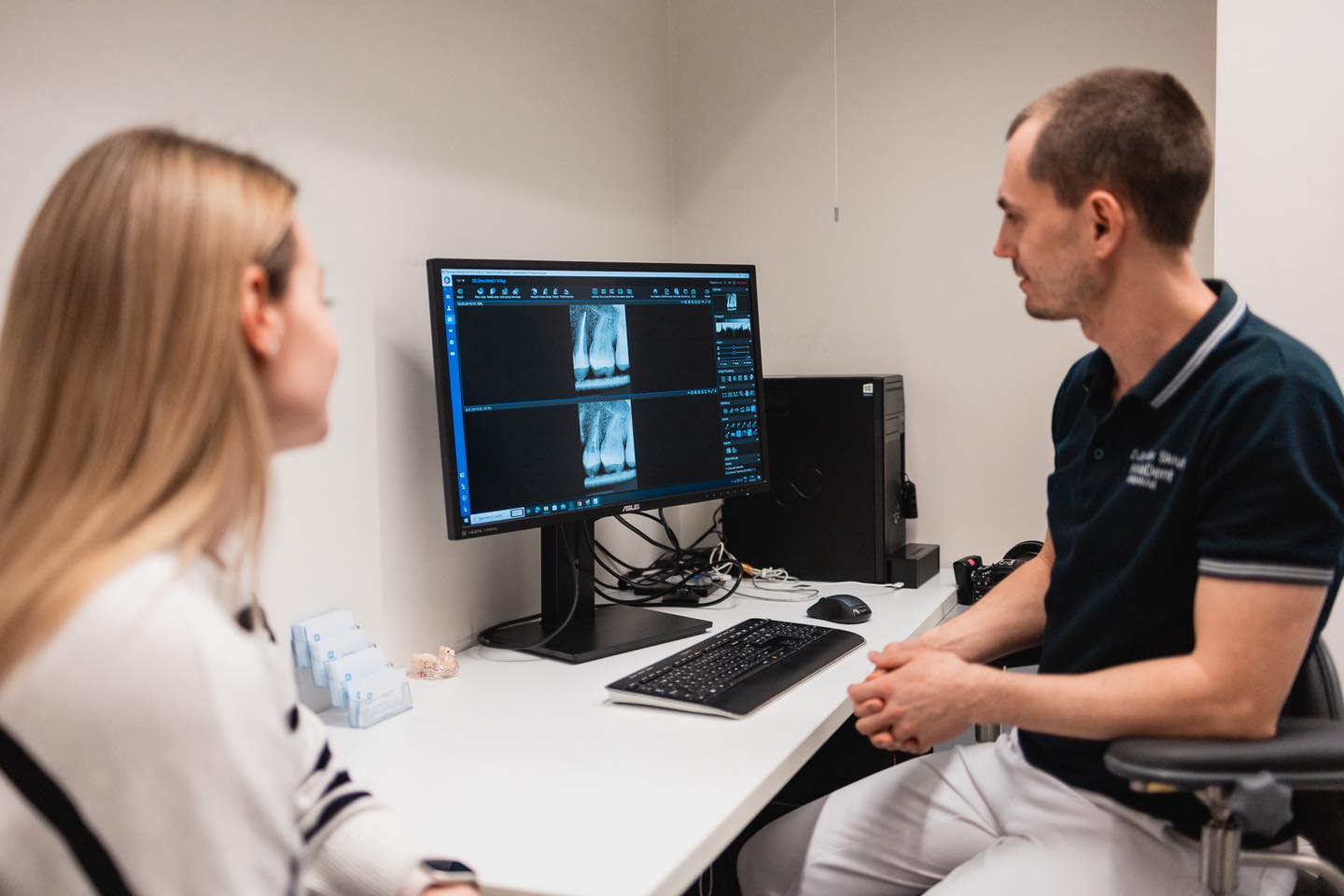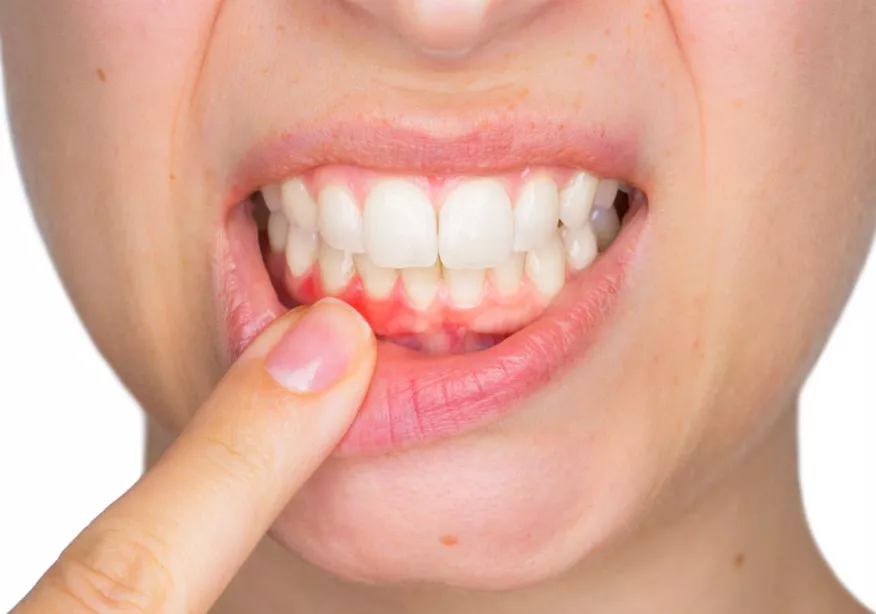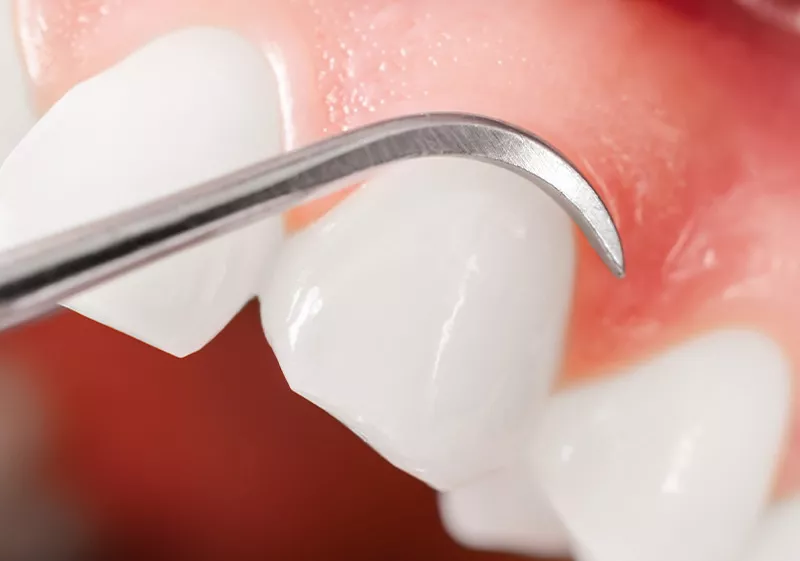
Gum Treatment
Healthy gums are the foundation of a beautiful smile! Gum treatment at HanzaDenti helps prevent and treat gum disease, restoring gum health and strength. Find out more and book an appointment today!
Book a visitModern Technology
Quality Guarantee
Quick and Convenient Booking
Gum Treatment in Tallinn
Gum treatment in Tallinn is available at all three of our clinics.
How can I tell if I have gum disease and need treatment?
The first signs of gum disease, indicating the need for treatment, include bad breath, bleeding gums, increased tooth mobility, changes in tooth position, and the appearance of gaps between teeth. These are caused by poor oral hygiene, smoking, and genetic predisposition.
What is the most common gum disease?
The most common gum disease is periodontitis, an inflammation of the tissues surrounding the teeth. Over time, periodontitis destroys the bone supporting the teeth, leading to tooth mobility, painful chewing, and eventual tooth loss. Periodontitis generally occurs in adults and is a chronic condition, but it can also affect children and adolescents, where it may be highly aggressive and requires treatment.
What causes periodontitis?
The cause is harmful bacteria living in the mouth and tartar formed from dental plaque. Plaque consists of bacteria that multiply, forming layers. The underlying bacteria die, and minerals from saliva accumulate between them, resulting in tartar. Tartar forms on the tooth surface and spreads below the gum, breaking down the tooth’s attachment to the jawbone.
How is gum treatment performed?
The primary treatment is regular removal of plaque and tartar. Home oral hygiene also plays a crucial role. Regular dental check-ups and professional cleaning are essential. Advanced periodontitis, which causes bone damage, may require surgical treatment, but methods depend on the patient’s specific condition, disease severity, and willingness to cooperate.
How often should a periodontitis patient visit the dentist?
Such patients should see their dentist at least every six months unless otherwise directed by their gum specialist.
Pricelist
Gum treatment prices: Check out the basic prices and book an appointment today!
All prices| SERVICE | PRICE |
| Consultation | from 70€ |
| Anesthesia | 23€ |
| Periodontal status 1 sector | 50€ |
| Surgical treatment of gingival recession 1 area | 650€ |
Satisfied customers
47000+

Customer Reviews
First-class service, truly impressive. I will definitely come back again!

Aleksandr Shmanjov
Dr. Alina Ismailova is very pleasant and professional.

Angelica Tahker
A very polite, professional, and attentive dentist, Dr. Rasmus Peeker!
My previous visits to the dentist were quite painful, especially the removal of a wisdom tooth. However, I went to Dr. Rasmus Peeker, and the wisdom tooth extraction was absolutely painless! Highly recommend!

Nadezda Zdanova
Great dentists who do their job well, both in treatment and consultation. In particular, Dr. Ermel's advice helped me take better care of my teeth, so I don't need to visit the dentist as often as I used to.

Aleksis Anijärv
Everyone welcomed me very warmly. The doctor has always worked quickly, painlessly, and with high quality. Now I visit Hanzadent twice a year for regular check-ups to make sure everything is fine and to feel more confident!

Stiven Lipetski
Dentists
Useful information
Process
1
Consultation and planning
The dentist assesses the condition of the gums, identifies inflammation or disease processes, and, if necessary, takes X-rays to create an individual treatment plan.
2
Preparation for the procedure
Professional oral hygiene is performed, removing plaque and tartar accumulated under the gums to prepare the gums for treatment.
3
Performing the procedure
Depending on the diagnosis, anti-inflammatory treatment, deep cleaning, or, if necessary, surgical procedures are performed to restore gum health.
Contraindications
We do not recommend gum treatment in the following cases: acute systemic infections, uncontrolled diabetes, blood clotting disorders, allergies to medications or materials, severe oral mucosal diseases, or psychological conditions that prevent procedures.
- Acute systemic infections
- Uncontrolled diabetes
- Blood clotting disorders
- Allergies to medications or materials
- Severe oral mucosal diseases
- Psychological conditions


Dentist's advice
Dentist’s Advice: What happens if you delay gum treatment?
- Tooth loss – Untreated gum inflammation leads to destruction of tissues and bone around the tooth root, causing tooth loss.
- Spread of inflammation in the body – Periodontitis increases the risk of heart disease, diabetes, Alzheimer’s, and other serious illnesses.
- Chronic pain and bleeding – Gum inflammation causes constant discomfort, swelling, and bleeding, making daily life difficult.
- More complex and expensive treatment – Delaying treatment may require complex surgical procedures and increase costs.
- Aesthetic and functional issues – Damaged gums and tooth loss affect appearance and make eating and speaking difficult.
Don’t risk your teeth and health – contact HanzaDent specialists today!
FAQ

Mihkel 32 y.
18.12.2024
Why treat gum disease at the first symptoms?
Mihkel 32 y. 18.12.2024
Answer:
Treating gum disease is an ongoing process. If the disease has already progressed, it cannot be completely cured. It can only be controlled to prevent further progression.
In many cases, surgical intervention is not necessary, and the disease can be managed through non-surgical procedures. This is a more cost-effective and convenient solution for the patient. Therefore, it is in the patient’s best interest to see a dentist as soon as the first symptoms appear.
If gum inflammation (plaque and tartar are not removed) is left untreated, the supporting tissues around the teeth begin to deteriorate. The tooth’s attachment to the jawbone weakens, and deep pockets form between the tooth root and gum, providing an ideal environment for bacteria causing periodontitis to grow. Removing tartar and plaque from these pockets becomes nearly impossible for both the patient and the dentist.
The outcome of gum disease treatment depends largely on the patient’s commitment to controlling the disease. The primary condition is regular visits to the dentist to monitor the condition of the teeth, perform professional plaque and tartar removal, and carry out surgical curettage if necessary. Daily oral hygiene, tooth brushing, and cleaning between the teeth extend the effectiveness of the treatment.
If periodontitis has advanced to the point of forming bone pockets, these can, in some cases, be surgically cleaned and restored using artificial bone.

Laura 27 y.
18.12.2024
Why is it important to remove tartar from both the tooth surface and under the gum?
Laura 27 y. 18.12.2024
Answer:
Tartar forms from dental plaque left on the teeth. Plaque consists of bacteria that multiply, creating new layers. The underlying bacteria die, and minerals from saliva accumulate between and inside them, forming tartar. Tartar deposits on both the tooth crown and below the gum, destroying the tooth’s attachment to the jawbone.
Tartar removal from under the gum is performed using special instruments and is called curettage. Both tartar removal from the visible tooth surface and curettage are typically carried out under local anesthesia.

Katrin 45 y.
18.12.2024
Is gum treatment a painful procedure?
Katrin 45 y. 18.12.2024
Answer:
Gum treatment and tartar removal can be a painful procedure, so if necessary, the patient will be given anesthesia either before the procedure begins or during the procedure.

Andres 38 y.
18.12.2024
How to recognize the symptoms of gum disease?
Andres 38 y. 18.12.2024
Answer:
The first and most important symptom of gum disease is bleeding gums when brushing your teeth. It is also important to check your gums in the mirror to make sure they are still beautiful, pink, and in their proper place. If a person notices any changes, they should see a dentist immediately.

Kristiina 29 y.
18.12.2024
How to prevent gum disease from recurring after treatment?
Kristiina 29 y. 18.12.2024
Answer: Every patient with gum disease will be explained by their doctor exactly how they should act to prevent the problem from recurring. It is important to brush their teeth very well (an electric toothbrush is helpful here) and have regular check-ups.





